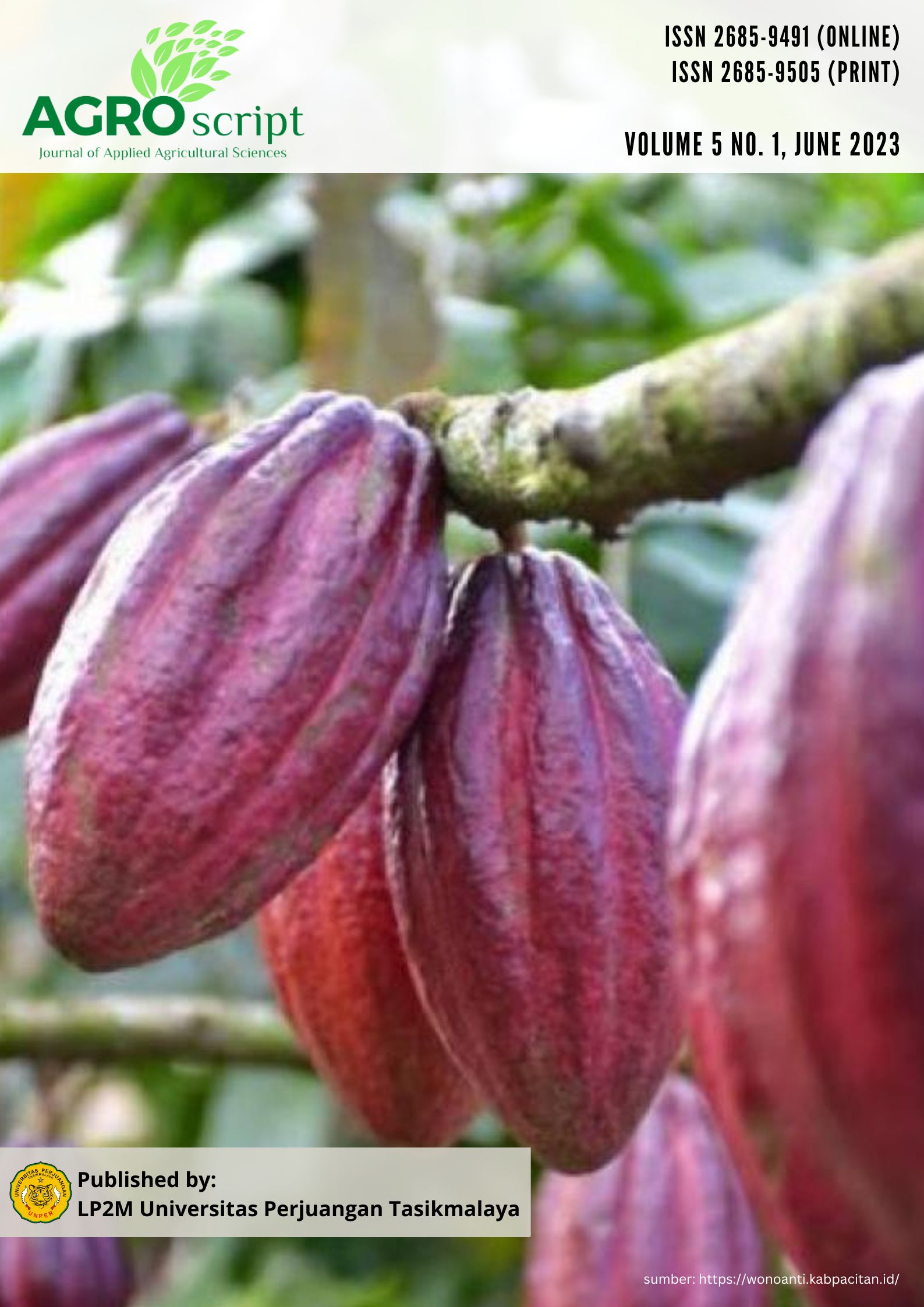Pengaruh Invigorasi dan Pelapisan terhadap Viabilitas Benih Terong yang Mengalami Kemunduran
DOI:
https://doi.org/10.36423/agroscript.v5i1.1216Keywords:
Solanaceae, Mutu, Biopriming, Viabilitas, vigorAbstract
Invigorasi dan pelapisan benih merupakan salah satu upaya dalam meningkatkan mutu benih melalui peningkatan permeabilitas dinding sel dan penambahan bahan pada lapisan kulit benih. Penelitian ini bertujuan untuk melihat pengaruh perlakuan invigorasi dan pelapisan benih terhadap viabilitas benih terong yang telah mengalami kemunduran. Penelitian menggunakan rancangan acak lengkap yang terdiri dari 7 perlakuan, yaitu kontrol (M0), matriconditioning dengan air (M1), matriconditioning dengan 200 ppm asam askorbat (M2), pelapisan dengan pelapis dasar (arabic gum) (M3), pelapisan dengan pelapis dasar + bakteri Pseudomonas flourescens (M4), pelapisan dengan bakteri + matriconditioning air (M5), pelapisan dengan bakteri + matriconditioning asam askorbat (M6). Hasil penelitian menunjukkan adanya pengaruh peningkatan pertumbuhan kecambah dengan perlakuan invigorasi dan pelapisan benih dibandingkan dengan kontrol. Daya berkecambah dan indeks vigor benih dengan perlakuan M5 dan M6 secara nyata menunjukkan hasil yang lebih tinggi dibandingkan dengan perlakuan lainnya, sedangkan panjang kecambah tidak dipengaruhi oleh perlakuan invigorasi dan pelapisan benih.
References
Accinelli, C., Abbas, H. K., & Shier, W. T. (2018). A bioplastic-based seed coating improves seedling growth and reduces production of coated seed dust. Journal of Crop Improvement, 32(3), 318–330. https://doi.org/10.1080/15427528.2018.1425792
Adams, C. A., & Rinne, R. W. (1980). Moisture content as a controlling factor in seed development and germination. In International Review of Cytology (Vol. 68, pp. 1–8). Elsevier. https://doi.org/10.1016/S0074-7696(08)62305-0
Adetunji, A. E., Adetunji, T. L., Varghese, B., Sershen, & Pammenter, N. W. (2021). Oxidative stress, ageing and methods of seed invigoration: an overview and perspectives. Agronomy, 11(12), 2369. https://doi.org/10.3390/agronomy11122369
Alsamadany, H., & Ahmed, Z. (2022). Assessing aging impact on growth potential of Vitamin E primed soybean seeds via biochemical profiling. Saudi Journal of Biological Sciences, 29(5), 3717–3726. https://doi.org/10.1016/j.sjbs.2022.03.013
Elbaum, R., & Abraham, Y. (2014). Insights into the microstructures of hygroscopic movement in plant seed dispersal. Plant Science, 223, 124–133. https://doi.org/10.1016/j.plantsci.2014.03.014
Elkelish, A., Qari, S. H., Mazrou, Y. S. A., Abdelaal, K. A. A., Hafez, Y. M., Abu-Elsaoud, A. M., Batiha, G. E.-S., El-Esawi, M. A., & El Nahhas, N. (2020). Exogenous ascorbic acid induced chilling tolerance in tomato plants through modulating metabolism, osmolytes, antioxidants, and transcriptional regulation of catalase and heat shock proteins. Plants, 9(4), 431. https://doi.org/10.3390/plants9040431
Fitriani, F., Amri, Y., Bahri, S., & Nadilla, F. (2021). Pengaruh bio-invigorasi benih dan biofungisida dari Ganoderma sp. untuk meningkatkan ketahanan dan mutu benih padi gogo. Jurnal Agrotek Tropika, 9(2), 345. https://doi.org/10.23960/jat.v9i2.4694
Gammoudi, N., Karmous, I., Zerria, K., Loumerem, M., Ferchichi, A., & Nagaz, K. (2020). Efficiency of pepper seed invigoration through hydrogen peroxide priming to improve in vitro salt and drought stress tolerance. Horticulture, Environment, and Biotechnology, 61(4), 703–714. https://doi.org/10.1007/s13580-020-00260-8
Herawati, E., Rianto, F., & Palupi, T. (2021). Invigorasi benih padi menggunakan mikroba fungsional. Jurnal Agrotek Tropika, 9(2), 291–299. http://dx.doi.org/10.23960/jat.v9i2.4935
Hozayn, M., & Ahmed, A. A. (2019). Effect of Magneto-priming by tryptophan and ascorbic acid on germination attributes of barley (Hordeum vulgare L.) under salinity stress. EurAsian Journal of BioSciences, 13, 245–251.
Ilyas, S., Asie, K. V., Sutariati, G. A. K., & Sudarsono. (2015). Biomatriconditioning or biopriming with biofungicides or biological agents applied on hot pepper (Capsicum annuum L.) seeds reduced seedborne Colletotrichum capsici and increased seed quality and yield. Acta Horticulturae, 1105, 89–96. https://doi.org/10.17660/ActaHortic.2015.1105.13
Kawhena, T. G., Tsige, A. A., Opara, U. L., & Fawole, O. A. (2020). Application of gum arabic and Methyl cellulose coatings enriched with thyme oil to maintain quality and extend shelf life of “Acco” pomegranate arils. Plants, 9(12), 1690. https://doi.org/10.3390/plants9121690
Khan, A. Z., Shah, T., Khan, S., Rehman, A., Akbar, H., Muhammad, A., & Khalil, S. K. (2017). Influence of seed invigoration techniques on germination and seedling vigor of maize (Zea mays L.). Cercetari Agronomice in Moldova, 50(3), 61–70. https://doi.org/10.1515/cerce-2017-0026
Klarod, K., Dongsansuk, A., Piepho, H.-P., & Siri, B. (2021). Seed coating with plant nutrients enhances germination and seedling growth, and promotes total dehydrogenase activity during seed germination in tomato (Lycopersicon esculentum). Seed Science and Technology, 49(2), 107–124. https://doi.org/10.15258/sst.2021.49.2.03
Ma, Y. (2019). Seed coating with beneficial microorganisms for precision agriculture. Biotechnology Advances, 37(7), 107423. https://doi.org/10.1016/j.biotechadv.2019.107423
Madany, M., & Khalil, R. (2017). Seed priming with ascorbic acid or calcium chloride mitigates the adverse effects of drought stress in sunflower (Helianthus annuus L.) seedlings. The Egyptian Journal of Experimental Botany (Botany), 1. https://doi.org/10.5455/egyjebb.20170409090612
Nahampun, V. D., & Kusmiyati, F. (2018). Pengaruh pelapisan benih dengan Polyethylene glycol (PEG) dan lama penyimpanan terhadap viabilitas benih tomat ceri (Solanum lycopersicum var. Cerasiforme). J. Agro Complex, 2(3), 235–243. https://doi.org/DOI: https://doi.org/10.14710/joac.2.3.235-243
Narfiah, H. H., Trifawa, A., & Nurdiana, D. (2020). Invigorasi benih buncis (Phaseolus vulgaris L.) yang telah mengalami penyimpanan selama delapan bulan dengan berbagai bahan matriconditioning. Jagros: Jurnal Agroteknologi dan Sains (Journal of Agrotechnology Science), 4(1), 173. https://doi.org/10.52434/jagros.v4i1.869
Prabawa, P. S., Parmila, I. P., & Suarsana, M. (2020). Invigorasi benih sawi pagoda (Brassica narinosa) kadaluarsa dengan berbagai konsentrasi zat pengatur tumbuh alami. Agro Bali : Agricultural Journal, 3(1), 91–97. https://doi.org/10.37637/ab.v3i1.462
Putri, S. K., & Majid, A. (2019). Efektivitas pelapisan benih (seed coating) berbahan aktif cendawan antagonis untuk mengendalikan penyakit rebah kecambah (damping off) kacang tanah. Jurnal Pengendalian Hayati, 2(1), 23. https://doi.org/10.19184/jph.v2i1.17136
Rivas-Franco, F., Hampton, J. G., Morán-Diez, M. E., Narciso, J., Rostás, M., Wessman, P., Jackson, T. A., & Glare, T. R. (2019). Effect of coating maize seed with entomopathogenic fungi on plant growth and resistance against Fusarium graminearum and Costelytra giveni. Biocontrol Science and Technology, 29(9), 877–900. https://doi.org/10.1080/09583157.2019.1611736
Rocha, I., Ma, Y., Vosátka, M., Freitas, H., & Oliveira, R. S. (2019). Growth and nutrition of cowpea (Vigna unguiculata) under water deficit as influenced by microbial inoculation via seed coating. Journal of Agronomy and Crop Science, 205(5), 447–459. https://doi.org/10.1111/jac.12335
Shah, T., Latif, S., Khan, H., Munsif, F., & Nie, L. (2019). Ascorbic acid priming enhances seed germination and seedling growth of winter wheat under low temperature due to late sowing in Pakistan. Agronomy, 9(11), 757. https://doi.org/10.3390/agronomy9110757
Sucianto, Y. A., Sutarno, S., & Anwar, S. (2019). Invigorasi benih kelor (Moringa oleifera) dengan berbagai konsentrasi dan jenis zpt terhadap pertumbuhan dan bobot biomasa. Buletin Anatomi dan Fisiologi, 4(2), 137–143. https://doi.org/10.14710/baf.4.2.2019.137-143.
Downloads
Published
How to Cite
Issue
Section
License
Copyright (c) 2023 AGROSCRIPT: Journal of Applied Agricultural Sciences

This work is licensed under a Creative Commons Attribution-NonCommercial-ShareAlike 4.0 International License.
The Authors submitting a manuscript do so on the understanding that if accepted for publication, copyright of the article shall be transferred to AGROSCRIPT Journal of Applied Agricultural Sciences
This is an open-access journal in accordance with the Creative Commons Attribution-ShareAlike 4.0 International (CC BY-SA 4.0) license.
![]()









